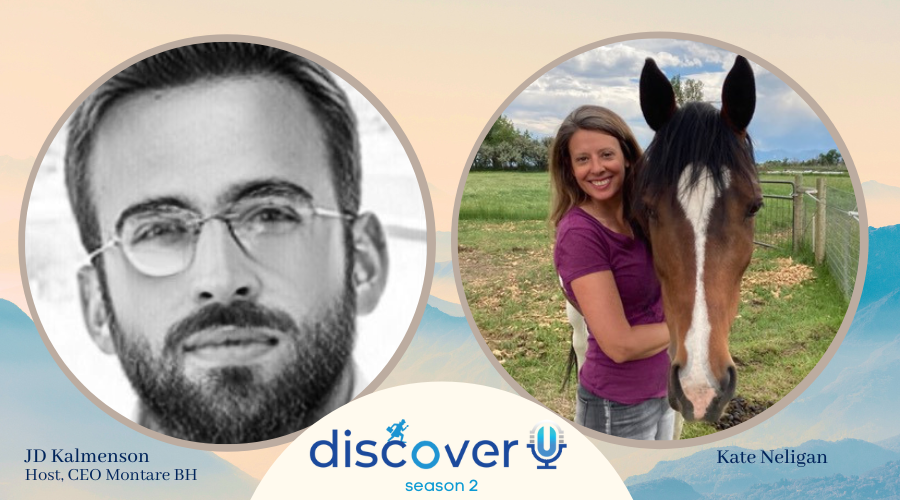In a recent Discover U podcast, CEO of Montare Behavioral Health JD Kalmenson interviews Kate Neligan about using horses as a tool in behavioral health counseling. Equine-assisted therapy and coaching (also known as equestrian therapy, hippotherapy, or simply horse-therapy) has roots in Ancient Greek antiquity, but has more recently been developed since the second half of the twentieth century to treat a wide variety of mental and physical ailments. The horse-human bond is ancient, and the memory of the two species collaborating over thousands of years brings potency to their therapeutic relationship.
Most providers distinguish between riding-based therapies which are generally used to treat developmental and physical disorders, and non-riding based therapies which facilitate connections between patients and horses to improve mental health. Neligan shares her experience using horses as a key component of her coaching practice, describing how they have helped her clients achieve key insights, and deeper connections with themselves and others. Working with horses offers many benefits, both as a stand-alone modality, and also when used in tandem with more traditional psychotherapeutic practices.
What kinds of mental health disorders can equine-assisted therapy treat?
Studies have shown that equine-assisted therapy is effective in treating a variety of mental health challenges, including:
- ADHD
- Addiction
- PTSD
- Anxiety
Depending on the individual clients’ needs, the provider may choose to bring the horse in direct contact with the client, or have the client observe from outside the ring. In addition to treating mental health disorders in individuals, equine-assisted therapy can be used in a group setting to facilitate stronger and healthier human connections. Whether in the context of business, family, or romantic relationships, horse therapies may be able to develop and maintain lines of communication and trust between people.
How does equine-assisted therapy treat mental health disorders?
Equine-assisted therapies which treat mental health disorders focus on the immediate and experiential aspects of caring for and being around horses. The size and physical presence of the animal has a profound effect on therapeutic practice, as well as the shift from the office setting of most talk therapies, to the barn.
There are a variety of ways that providers offer equine-assisted therapies. Individual psychotherapists may contract with equine coaches to work together with their patient as a supplement to talk therapy. Some providers exclusively work with horses and patients without a separate form of practice. The right method of treatment depends on the patients’ needs and comfort level.
The specific horse itself also plays a large role in therapy. As Neligan comments, “the horses are our equals in this process, and we do need to work better with them as partners.” As the therapist guides patients in working with the horse, the horse also responds to and guides the patient: “they seem to know what a client needs, even if we don’t.”
Patients may ride, feed, walk with or pet the horse as a part of treatment. Sometimes after spending some time with the horse, the best way of forming a bond will become apparent simply through being together. Neligan states that working with the horse “is a very embodied way of learning,” meaning that the therapist acts as mediator in encouraging and understanding the psychological and physical dynamics at work within the setting, but the primary relationship develops between horse and patient.
As prey animals, horses are very sensitive. They detect the physical manifestations of attitudes, and respond without judgement. Neligan says of them: ”we often call them biofeedback machines.” They mirror a client’s mood and movements, making them apparent to the client. Tending to this feedback can help patients who struggle with many different kinds of internalized monologues as the horses’ responses bring the patient back to their immediate physical present. Because of their height and weight (often over 1200lbs), patients are drawn out of habitual ways of locating themselves in space, interrupting persistent and ingrained negative thinking patterns. Neligan believes that the sheer size of a horse’s heart creates a field of influence that can help clients who struggle with self-regulation and anxiety calm down and find inner harmony.
Equine-assisted therapy can help as a tool in developing skills in mindfulness for exactly this reason. Increasing awareness of persistent patterns of behavior opens possibilities for the client to make new choices, supported by the non-judgmental, supportive presence of another living being.
References:


